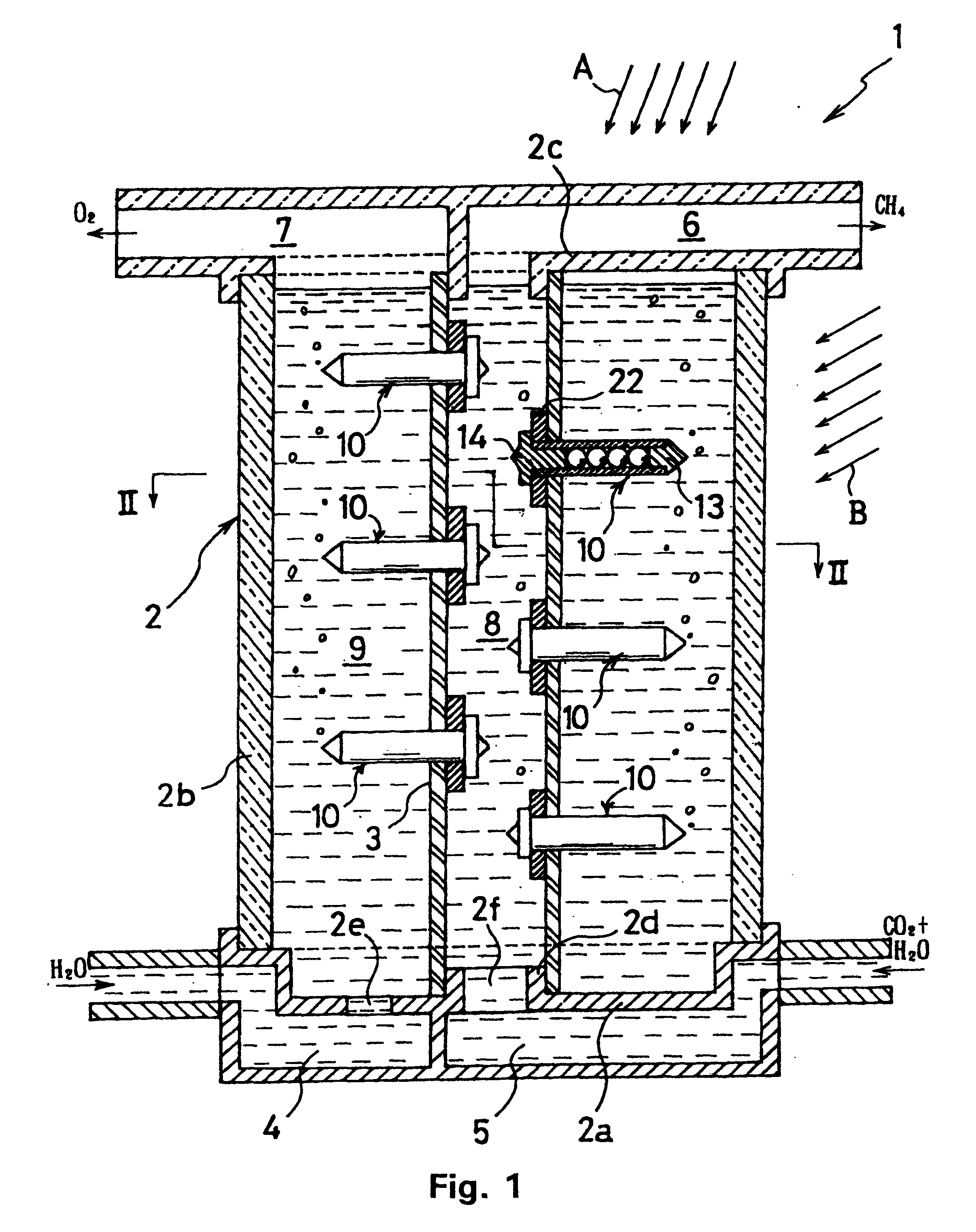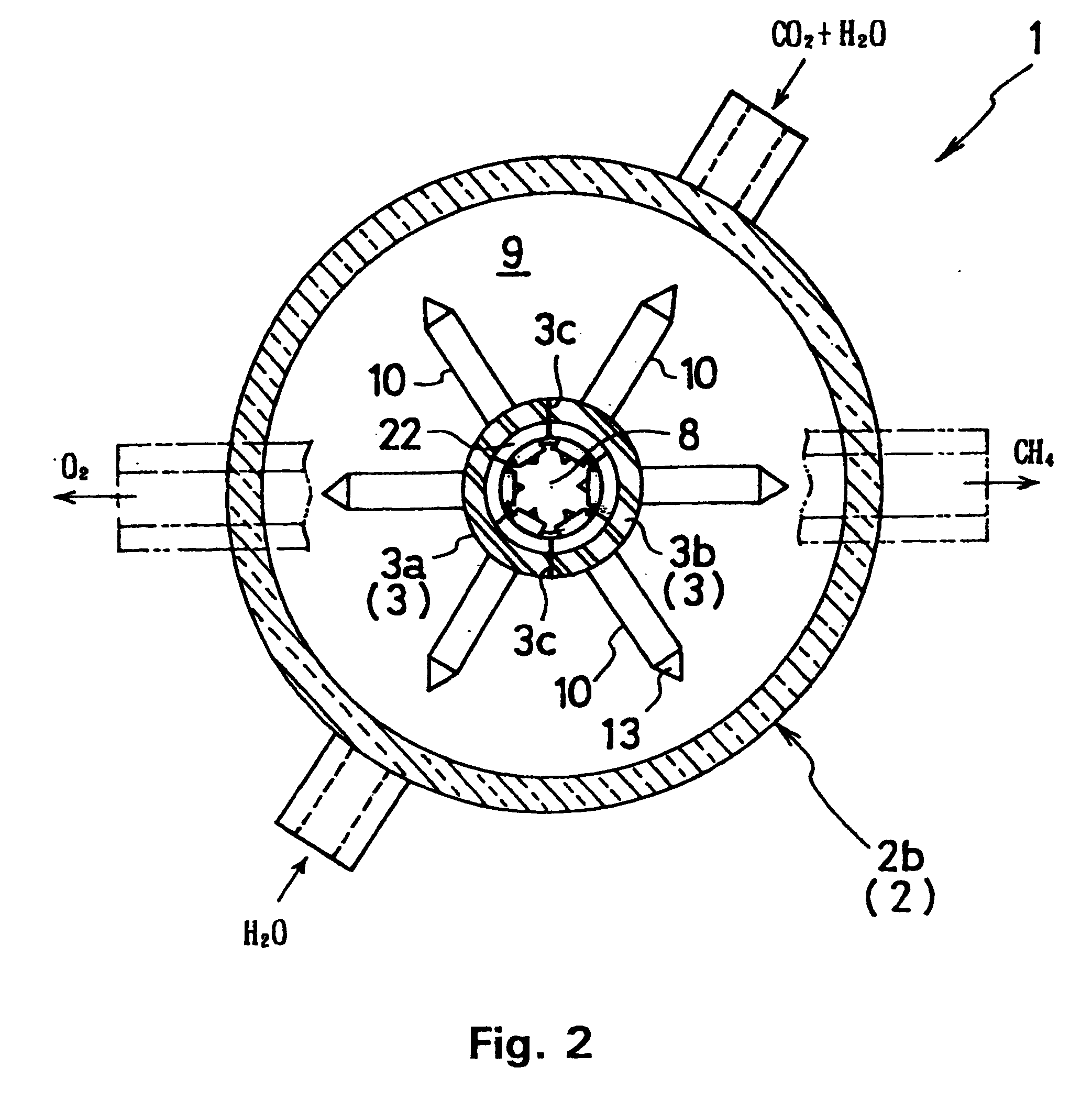Solar battery module for optical electrolysis device and optical electrolysis device
a technology of optical electrolysis and solar cells, which is applied in the direction of electrolysis components, pv power plants, energy input, etc., can solve the problems of low energy conversion efficiency with respect to sunlight, inability to use technology in practical use, and difficulty in increasing the light utilization rate in making use of light in a light spa
- Summary
- Abstract
- Description
- Claims
- Application Information
AI Technical Summary
Benefits of technology
Problems solved by technology
Method used
Image
Examples
example 1 (see figs.1-3)
Example 1 (see FIGS. 1-3)
Photoelectrolytic device 1 in this example is a device that electrolyzes, by the photoelectromotive force produced by solar energy, an electrolytic solution of water and carbon dioxide gas, producing methane gas (CH.sub.4) and oxygen gas (O.sub.2).
As shown in FIGS. 1 and 2, this photoelectrolytic device 1 has a container 2 of circular cross-section that accommodates the electrolyte, a cylindrical partition member 3 provided in the center of this container 2, multiple solar battery modules 10 mounted on this partition member 3 and piercing it radially, first supply port 4 for supplying water and second supply port 5 for supplying carbon dioxide gas formed on the base wall part 2a of container 2, and first lead-out port 6 for taking out the methane gas and second lead-out port 7 for taking out the oxygen gas, each formed in pipe shape integrally with cover part 2c of container 2.
The container 2 has base wall part 2a, which is made of stainless steel or another...
example 2 (see figs.5-7)
Example 2 (see FIGS. 5-7)
Photoelectrolytic device 30 in this example is a device that produces hydrogen gas (H.sub.2) and oxygen gas (O.sub.2) by electrolyzing water as the electrolyte, powered by the photoelectromotive force generated by solar energy.
As shown in FIGS. 5 and 6, this photoelectrolytic device 30 has container 31, which has a circular cross-section, partition member 34, which partitions its interior into reduction reaction chamber 32 and oxidation reaction chamber 33, and, for example, 15 solar battery modules 35, which are mounted piercingly on this partition member 34. This container 31 has base wall 31a, cylindrical wall part 31b, which is integral with this base wall 31a, and cover plate 31c, which covers the upper end of this cylindrical wall part 31b so that it can be opened and closed. Fixed in mutually facing positions on the inside surface of cylindrical wall part 31b are guide members 36, which are made of quartz glass or stainless steel and in which are form...
example 3 (see fig.8)
Example 3 (see FIG. 8)
As in the above example 2, photoelectrolytic device 50 in this example is a device that produces hydrogen gas (H.sub.2) and oxygen gas (O.sub.2) by electrolyzing water as the electrolyte, powered by the photoelectromotive force generated by solar energy.
As shown in FIG. 8, this photoelectrolytic device 50 has box-shaped container 51, which is made of, for example, sheet stainless steel; cover plate 52, which is made of transparent glass and covers the upper end of container 51 so that it can be opened and closed; five partition plates 54 (partition members) that partition the interior of container 51 into six reaction chambers 53a and 53b; for example, 21 solar battery modules 55 mounted in each partition plate 54; water supply tube 59; oxygen gas lead-out tube 57; and hydrogen gas lead-out tube 58. On the inside surface of the side walls at the front and back of container 51 are glass or stainless-steel guide members 56 for mounting partition plates 54, and fi...
PUM
| Property | Measurement | Unit |
|---|---|---|
| thickness | aaaaa | aaaaa |
| electrolysis voltage | aaaaa | aaaaa |
| overvoltage | aaaaa | aaaaa |
Abstract
Description
Claims
Application Information
 Login to View More
Login to View More - R&D
- Intellectual Property
- Life Sciences
- Materials
- Tech Scout
- Unparalleled Data Quality
- Higher Quality Content
- 60% Fewer Hallucinations
Browse by: Latest US Patents, China's latest patents, Technical Efficacy Thesaurus, Application Domain, Technology Topic, Popular Technical Reports.
© 2025 PatSnap. All rights reserved.Legal|Privacy policy|Modern Slavery Act Transparency Statement|Sitemap|About US| Contact US: help@patsnap.com



